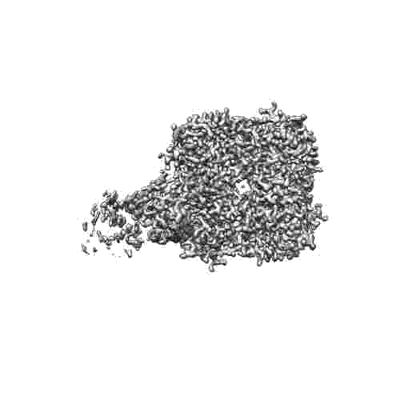EMD-29709
N2 neuraminidase of A/Tanzania/205/2010 H3N2 with S245N S247T mutations in complex with one FNI17 Fab molecule
EMD-29709
Single-particle2.3 Å
 Deposition: 08/02/2023
Deposition: 08/02/2023Map released: 31/05/2023
Last modified: 09/10/2024
Sample Organism:
Influenza A virus,
Homo sapiens
Sample: One FNI17 Fab in complex with tetrameric N2 NA protein from A/Tanzania/2010 strain with S245N S247T mutations
Fitted models: 8g3r (Avg. Q-score: 0.626)
Deposition Authors: Dang HV ,
Snell G
,
Snell G 
Sample: One FNI17 Fab in complex with tetrameric N2 NA protein from A/Tanzania/2010 strain with S245N S247T mutations
Fitted models: 8g3r (Avg. Q-score: 0.626)
Deposition Authors: Dang HV
 ,
Snell G
,
Snell G 
A pan-influenza antibody inhibiting neuraminidase via receptor mimicry.
Momont C,
Dang HV  ,
Zatta F,
Hauser K,
Wang C,
di Iulio J
,
Zatta F,
Hauser K,
Wang C,
di Iulio J  ,
Minola A,
Czudnochowski N,
De Marco A,
Branch K,
Donermeyer D,
Vyas S,
Chen A
,
Minola A,
Czudnochowski N,
De Marco A,
Branch K,
Donermeyer D,
Vyas S,
Chen A  ,
Ferri E,
Guarino B,
Powell AE,
Spreafico R
,
Ferri E,
Guarino B,
Powell AE,
Spreafico R  ,
Yim SS
,
Yim SS  ,
Balce DR,
Bartha I,
Meury M,
Croll TI,
Belnap DM
,
Balce DR,
Bartha I,
Meury M,
Croll TI,
Belnap DM  ,
Schmid MA
,
Schmid MA  ,
Schaiff WT,
Miller JL,
Cameroni E,
Telenti A
,
Schaiff WT,
Miller JL,
Cameroni E,
Telenti A  ,
Virgin HW,
Rosen LE
,
Virgin HW,
Rosen LE  ,
Purcell LA
,
Purcell LA  ,
Lanzavecchia A,
Snell G
,
Lanzavecchia A,
Snell G  ,
Corti D
,
Corti D  ,
Pizzuto MS
,
Pizzuto MS 
(2023) Nature , 618 , 590 - 597
 ,
Zatta F,
Hauser K,
Wang C,
di Iulio J
,
Zatta F,
Hauser K,
Wang C,
di Iulio J  ,
Minola A,
Czudnochowski N,
De Marco A,
Branch K,
Donermeyer D,
Vyas S,
Chen A
,
Minola A,
Czudnochowski N,
De Marco A,
Branch K,
Donermeyer D,
Vyas S,
Chen A  ,
Ferri E,
Guarino B,
Powell AE,
Spreafico R
,
Ferri E,
Guarino B,
Powell AE,
Spreafico R  ,
Yim SS
,
Yim SS  ,
Balce DR,
Bartha I,
Meury M,
Croll TI,
Belnap DM
,
Balce DR,
Bartha I,
Meury M,
Croll TI,
Belnap DM  ,
Schmid MA
,
Schmid MA  ,
Schaiff WT,
Miller JL,
Cameroni E,
Telenti A
,
Schaiff WT,
Miller JL,
Cameroni E,
Telenti A  ,
Virgin HW,
Rosen LE
,
Virgin HW,
Rosen LE  ,
Purcell LA
,
Purcell LA  ,
Lanzavecchia A,
Snell G
,
Lanzavecchia A,
Snell G  ,
Corti D
,
Corti D  ,
Pizzuto MS
,
Pizzuto MS 
(2023) Nature , 618 , 590 - 597
Abstract:
Rapidly evolving influenza A viruses (IAVs) and influenza B viruses (IBVs) are major causes of recurrent lower respiratory tract infections. Current influenza vaccines elicit antibodies predominantly to the highly variable head region of haemagglutinin and their effectiveness is limited by viral drift1 and suboptimal immune responses2. Here we describe a neuraminidase-targeting monoclonal antibody, FNI9, that potently inhibits the enzymatic activity of all group 1 and group 2 IAVs, as well as Victoria/2/87-like, Yamagata/16/88-like and ancestral IBVs. FNI9 broadly neutralizes seasonal IAVs and IBVs, including the immune-evading H3N2 strains bearing an N-glycan at position 245, and shows synergistic activity when combined with anti-haemagglutinin stem-directed antibodies. Structural analysis reveals that D107 in the FNI9 heavy chain complementarity-determinant region 3 mimics the interaction of the sialic acid carboxyl group with the three highly conserved arginine residues (R118, R292 and R371) of the neuraminidase catalytic site. FNI9 demonstrates potent prophylactic activity against lethal IAV and IBV infections in mice. The unprecedented breadth and potency of the FNI9 monoclonal antibody supports its development for the prevention of influenza illness by seasonal and pandemic viruses.
Rapidly evolving influenza A viruses (IAVs) and influenza B viruses (IBVs) are major causes of recurrent lower respiratory tract infections. Current influenza vaccines elicit antibodies predominantly to the highly variable head region of haemagglutinin and their effectiveness is limited by viral drift1 and suboptimal immune responses2. Here we describe a neuraminidase-targeting monoclonal antibody, FNI9, that potently inhibits the enzymatic activity of all group 1 and group 2 IAVs, as well as Victoria/2/87-like, Yamagata/16/88-like and ancestral IBVs. FNI9 broadly neutralizes seasonal IAVs and IBVs, including the immune-evading H3N2 strains bearing an N-glycan at position 245, and shows synergistic activity when combined with anti-haemagglutinin stem-directed antibodies. Structural analysis reveals that D107 in the FNI9 heavy chain complementarity-determinant region 3 mimics the interaction of the sialic acid carboxyl group with the three highly conserved arginine residues (R118, R292 and R371) of the neuraminidase catalytic site. FNI9 demonstrates potent prophylactic activity against lethal IAV and IBV infections in mice. The unprecedented breadth and potency of the FNI9 monoclonal antibody supports its development for the prevention of influenza illness by seasonal and pandemic viruses.
